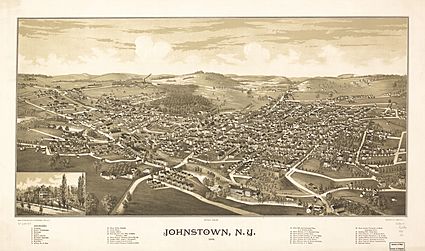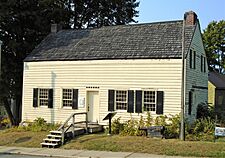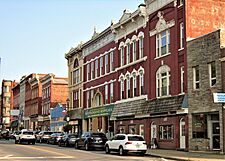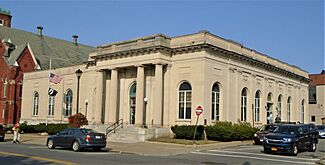Johnstown, New York facts for kids
Quick facts for kids
Johnstown
|
|
|---|---|
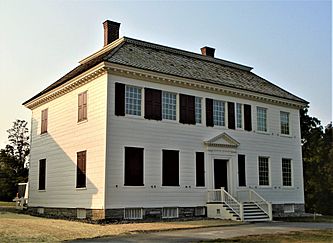
Johnson Hall, home of Sir William Johnson, New York State Historic Site (2020)
|
|
| Nickname(s):
+
|
|
| Country | United States |
| State | New York |
| County | Fulton |
| Settled | 1758 |
| Incorporated | 1803 (village) 1895 (city) |
| Founded by | Sir William Johnson |
| Government | |
| • Type | (Mayor-Council) |
| Area | |
| • Total | 4.82 sq mi (12.50 km2) |
| • Land | 4.82 sq mi (12.49 km2) |
| • Water | 0.00 sq mi (0.01 km2) |
| Elevation | 673 ft (205 m) |
| Population
(2020)
|
|
| • Total | 8,204 |
| • Density | 1,702.07/sq mi (657.11/km2) |
| Time zone | UTC-5 (Eastern (EST)) |
| • Summer (DST) | UTC-4 (EDT) |
| ZIP code |
12095
|
| Area code(s) | 518 |
| FIPS code | 36-38781 |
| GNIS feature ID | 0954147 |
Johnstown is a city in Fulton County, New York. It's the main city of the county. The city was named after its founder, Sir William Johnson, who was an important leader during the French and Indian War (also called the Seven Years' War).
Johnstown is about 45 miles (72 km) northwest of Albany. It's in the Mohawk Valley area, near the Adirondack Mountains. The city is mostly surrounded by the Town of Johnstown. Nearby is the city of Gloversville. These two cities are known as the "Glove Cities." This is because they used to be a big center for making gloves and other leather items.
In 2020, about 8,204 people lived in Johnstown.
Contents
History of Johnstown
Early Beginnings
Sir William Johnson came to New York from Ireland in 1738. He was a trader who learned Native American languages and cultures. He became good friends with many Native American leaders, especially the Mohawks. Johnson's friendships helped him greatly during the French and Indian War. He was a major general in this war.
Because of his service, Johnson received large areas of land. He became one of New York's richest and most powerful people. He owned over 400,000 acres (1,600 km²) of land. Johnson started as a trader and then built sawmills and flour mills. He also had about 60 enslaved Africans working for him. Local Native Americans called him Warragghivage, meaning "he who does much business."
Johnson founded the village of Johnstown in 1762. He named it after his son, John Johnson. He built a free school for both Mohawk and white children. He also helped start St. John's Episcopal Church. In 1763, Johnson built a large home called Johnson Hall. He lived there until he died. Johnson Hall is now a National Historic Landmark. New York State runs it as a historic site.
As Johnson's land grew, he asked the governor to create a new county. This new county was named Tryon County, and Johnstown became its main city. The county courthouse in Johnstown was built by William Johnson in 1772. It is still used today and is the oldest operating courthouse in New York. Sir William Johnson died in 1774, before the American colonies declared independence from Britain.
The Revolutionary War and After
When the American Revolutionary War began, many British Loyalists left Johnstown. This included Johnson's son, John, and his family, who went to Canada. In 1779, the state took all of the Johnson family's property. This was because they supported the British. Johnson Hall was damaged by American soldiers living there. The house was later sold to Silas Talbot, a naval officer.
Most of the war happened elsewhere, but Johnstown did see some fighting. On October 25, 1781, about 1,400 soldiers fought in the Battle of Johnstown. This was one of the last battles of the Revolution. American forces, led by Col. Marinus Willett, defeated the British. The British had burned much of the Mohawk Valley before this battle.
After the war, Tryon County was renamed Montgomery County. Johnstown became part of this county.
From the 1800s to Today
In 1803, Johnstown became an official village. In 1838, Montgomery County was split into two counties: Montgomery and Fulton. Johnstown became the main city of Fulton County. In 1895, Johnstown officially became a city.
Elizabeth Cady Stanton, a famous women's rights activist, was born in Johnstown in 1815. She went to the Johnstown Academy.
In 1889, Johnstown had a terrible flood. The Cayadutta Creek overflowed, sweeping away buildings and bridges. More than twenty people were lost or drowned.
In 1906, New York State bought Johnson Hall to fix it up and save it.
Growth of Industries
Johnstown became a center for tanning leather in the late 1800s. This was because there were many hemlock trees, which provided wood bark for tanning. By the early 1900s, Johnstown and nearby Gloversville were known as the "Glove Cities." They were the glove-making capital of the world. Many other businesses supported the glove and leather industries. These included box makers, thread sellers, and sewing machine repair shops.
One important company in Johnstown was the Knox gelatine plant. Charles B. Knox started it in 1890. He created the granulated gelatin used in cooking today. When he died in 1908, his wife, Rose Knox, took over the business. She became one of America's first successful businesswomen. The Knox family was very generous to the city. They gave land for Knox Field, which has playgrounds and athletic fields. The Knox Gelatin plant closed in 1975.
Geography and Location
Johnstown is in the southern part of Fulton County. It is in the beautiful Mohawk Valley of upstate New York. The city is near the southern border of the Adirondack Park.
The city covers about 4.82 square miles (12.50 km²). Most of this is land. The city is surrounded by the Town of Johnstown. To the northeast is Gloversville. To the south is the town of Mohawk.
Cayadutta Creek flows through Johnstown. This creek provided water power for the city's industries. The creek flows south and joins the Mohawk River.
Important roads meet in Johnstown. New York State Route 29 and New York State Route 67 cross through the city. They also meet New York State Route 30A. These roads connect Johnstown to other towns and cities.
Population Information
| Historical population | |||
|---|---|---|---|
| Census | Pop. | %± | |
| 1870 | 3,282 | — | |
| 1880 | 5,013 | 52.7% | |
| 1890 | 7,768 | 55.0% | |
| 1900 | 10,130 | 30.4% | |
| 1910 | 10,447 | 3.1% | |
| 1920 | 10,908 | 4.4% | |
| 1930 | 10,801 | −1.0% | |
| 1940 | 10,666 | −1.2% | |
| 1950 | 10,923 | 2.4% | |
| 1960 | 10,390 | −4.9% | |
| 1970 | 10,045 | −3.3% | |
| 1980 | 9,360 | −6.8% | |
| 1990 | 9,058 | −3.2% | |
| 2000 | 8,511 | −6.0% | |
| 2010 | 8,743 | 2.7% | |
| 2020 | 8,204 | −6.2% | |
| U.S. Decennial Census | |||
In 2000, there were 8,511 people living in Johnstown. About 96.6% of the people were White. About 1.1% were Hispanic or Latino.
The population was spread out by age. About 24.4% were under 18 years old. About 19.2% were 65 years or older. The average age was 39 years.
The average income for a family in the city was $39,909. About 13.2% of the population lived below the poverty line.
Famous People from Johnstown
Silas Talbot
Silas Talbot moved to Johnstown and bought Sir William Johnson's estate. He was a hero of the American Revolution. He later served in the New York Assembly and in the U.S. House of Representatives.
In 1797, he helped build the USS Constitution ship. Talbot commanded this ship from 1799 to 1801.
Daniel Cady
Judge Daniel Cady was an important person in Johnstown. He helped create Fulton County. He named it after Robert Fulton, who invented the steamboat.
Daniel Cady was a wealthy lawyer and businessman. He served in the New York state legislature. He was also a judge on the New York Supreme Court. He died in Johnstown in 1859.
Elizabeth Cady Stanton
Daniel Cady is best known as the father of Elizabeth Cady Stanton. She was a very important women's rights activist. She was born in Johnstown in 1815.
Stanton studied at the Johnstown Academy. She later worked with Susan B. Anthony. She was president of the National Woman Suffrage Association. Johnstown is considered a birthplace of the women's rights movement. This is because Stanton helped organize the first Women's Rights Convention in 1848. Her speech there, the Declaration of Sentiments, helped start the women's suffrage movement in the U.S.
Other Notable People
- John D. McDonald (1816–1900) was born in Johnstown. He became a farmer and politician in Wisconsin.
- Israel T. Hatch was born in Johnstown. He became mayor of Buffalo, New York and a U.S. Congressman.
- George Linius Streeter was a famous scientist who studied how living things develop. He was the Director of the Carnegie Institution of Washington.
Gallery
-
The Knox Mansion was built in 1889 by Charles Knox, who made Knox gelatin.
See also
 In Spanish: Johnstown (Nueva York) para niños
In Spanish: Johnstown (Nueva York) para niños



